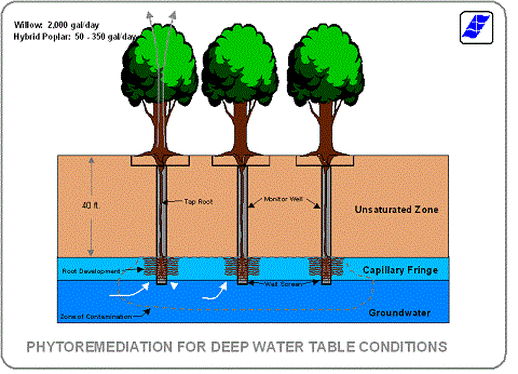

-Teen Biotech Challenge-
Bioremediation
 Spider plant |
|---|
 Arabidopsis halleri |
 Hydrangea |
 Duckweed |
 Alfalfa |
 The mangrove forests |
Phytoremediation
Process
 PhytostimulationPlant roots or rhizosphere provide microorganism habitat, sugar and carbohydrates, oxygen, and organic carbon. In turn, microorganisms accelerate biological degradation of toxin into a form plants can consume. |  PhytostabilizationThe plant’s roots absorbs contaminants and release chemicals that converts the contaminant into a nontoxic substance. It therefore immobilize contaminants through erosion, leaching, or wind and soil dispersion. |  HyperaccumulationPlant absorbs contaminants and water with nutrients to store the toxic in the plant’s aerial shoots or leaves and stems. (used for heavy led like nickel, zinc, and copper and may introduce chelating agents first) |
|---|---|---|
 PhytofilterationPlants used are raised in greenhouses with their roots in water and artificial soil medium is utilized. Then, groundwater is pumped to the surface to be taken by these plants. Afterwards, the plants are harvested and disposed of. (also known as rhizofiltration) |  PhytodegradationUsing enzymes produced by plants that catalyzes and speeds up chemical reaction in a plant’s metabolic process to break down contaminants and degrade it into simpler molecules that plant tissues can absorb to grow faster. |  PhytohydraulicTrees act as pumps to pull out contaminated water from the source. This prevent contaminated water from moving into drinking water or spreading into other areas. |
 PhytovolatilizationContaminants are taken in by plants and transpiration occurs where the modified contaminants are evaporated into the atmosphere. |
Application
-
sites with low concentration of contaminants in shallow soils, streams, and groundwater
-
radionuclides
-
pesticides
-
explosives
-
fuels
-
volatile organic compounds (voc)
-
perchlorate
-
radioactive (may introduce chelating agents first)
 |  |
|---|---|
 |  |
 |
Example:
Water Hyacinth: Water hyacinth are used for arsenic removal. The aqeous plant uses its fibrous root system to cover more surface area for absorption of arsenic. Not only is this method of phytoremediation cost effective since not much maintenance is needed, it can endure in highly toxic environment where other plants cannot. (4.37)
The table on the left depicts datas collected for water hyacinth in arsenic removal (4.37)


Hybrid Poplar:
These trees are used for degrading methyl tert-butyl ether, trichloroethylene, and other toxic contaminants. Hybrid poplar hyperaccumulate and degrade contaminants through the symbiosis relationship with microbes in the plant root. They grow fast with roots digging deep down into the soil which can uptake contaminants that reside deep in the soil. (4.49, 4.50)
Rinorea niccolifera
Discovered by scientist Los Banos in the western part of Luzon Island in Philippines, this plant is capable of accumulating 1,000 times more concentration of nickel than other plants. This plant use hyperaccumulation and can store up to 18,000 parts per million which is 100 to 1,000 more concentrated than other plants. In fact, only 450 plant species identified has been able to hyperaccumulate nickel. Eventually, this plant could be utilized for phytomining which involves hyperaccumulating plants to be grown and harvest for usage in metal-rich sites.


Sunflower:
Sunflower has the ability to hyperaccumulate heavy, toxic metals. Specifically, this plant have the ability to live in highly concentrated lead environment and hyperaccumulate lead. In addition, this plant was also planted around Chernobyl which is contaminated by radiation, to reduce 95% of radionuclides in 10 days. Using oxidative stress through sythesis of Net Positive Suction Head, Glutathione, and Glutathione Reductase, sunflowers are phytoremediator for lead contaminated sites. (4.47, 4.48)